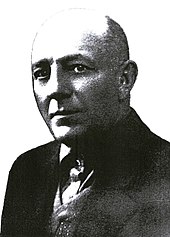Paul Schreier
Paul Schreier (born July 13, 1880 in Schönhorn, Stolpe manor in the Niederbarnim district ; † December 8, 1937 executed near Leningrad in the USSR ) was a German communal politician of the KPD .
Life
Paul Friedrich Karl Schreier was born on July 13, 1880 in the Schönhorn forest workers' house as the first child of a forest worker in the Stolper Heide, a wooded area between Hennigsdorf and Schönfließ belonging to the von Veltheim family. Schreier was baptized on August 15, 1880 in the Evangelical-Lutheran Stolper village church and spent the first years of his life in Schönhorn, then in Tegel and Velten . Nine siblings can be identified, some died early. After attending primary school and years of traveling , Schreier was a factory worker in Hennigsdorf, later a welder.
In 1902 he was a member of the SPD and then campaign worker for Karl Liebknecht in the constituency of Potsdam-Spandau-Osthavelland. From 1905 he lived in Hennigsdorf.
He was married twice, in his second marriage in 1918 he married the younger sister of the deceased first wife, and both marriages had seven children. The wives were from Poznan and were Catholic .
Schreier was a soldier in World War I , 1918 Landwehr man in a road construction company. At the end of 1918 he co-founded a Spartakus group and at the beginning of 1919 a local group of the KPD in Hennigsdorf, afterwards a member of the community council and head of the KPD local group and faction.
In March 1920, Schreier belonged to a workers' brigade, which on March 22, 1920 fought a violent firefight with the Baltic states who marched from Berlin and Döberitz to Hennigsdorf after the failed Kapp Putsch . Artillery was used in the battle, killing at least 17 people, including bystanders.
From around the mid-twenties Schreier worked for the KPD in Berlin-Brandenburg, until September 1933 he lived in Berlin. After the National Socialist seizure of power , he fled to the Soviet Union via Prague in mid- 1933 , living first in Moscow and then in Leningrad. On July 30, 1937, he was arrested in the course of the German operation of the NKVD , came before a Dwoika , was sentenced to death on December 2, 1937 and shot on December 8, 1937. Burial place is the Leningrad district of Levashovo.
In 1958 Schreier was declared dead by the Oranienburg District Court . Although the family researched the circumstances of his death before 1989, the facts only became public after the end of the GDR . A Soviet court rehabilitated him in 1989.
Honors
In 1968 a street, a square and a school were named after him in Hennigsdorf. A street in Marl was also named after him.
See also
Individual evidence
- ↑ Klaus Euhausen: Paul Schreier, Schönhorn 1880 - Leningrad 1937. A contribution to regional history . 2011.
- ↑ Levaschowo near Leningrad (Левашово; online ( memento of the original from July 5, 2007 in the Internet Archive ) Info: The archive link has been inserted automatically and has not yet been checked. Please check the original and archive link according to the instructions and then remove this note. ), ( accessed on August 24, 2010).
- ↑ Name giver of Schreierstrasse? In: Recklinghäuser Zeitung , July 3, 2019.
literature
- Hermann Weber , Andreas Herbst : German communists. Biographisches Handbuch 1918 to 1945. Dietz, Berlin 2004, ISBN 3-320-02044-7 , pp. 605–607 ( online , accessed on November 11, 2011; but wrong family name and wrong place of birth!).
- Ulla Plener , Natalia Mussienko (ed.): Sentenced to the maximum penalty: death by shooting . Karl Dietz Verlag, Berlin. 2006. pp. 88/89, ISBN 3-320-02080-3 . ( Online (PDF; 1.6 MB), accessed November 11, 2011)
- Hans-Joachim Fieber, among others: Resistance in Berlin against the Nazi regime from 1933 to 1945 . Volume 7. 2005. p. 139.
Web links
- Klaus Euhausen: Paul Schreier, Schönhorn 1880 - Leningrad 1937 (PDF; 1.1 MB)
- Klaus Euhausen: The fight for Hennigsdorf. Materials and facts about the Kapp Putsch and the events of March 1920 in Hennigsdorf and the surrounding area (PDF; 10 MB)
| personal data | |
|---|---|
| SURNAME | Screamers, Paul |
| ALTERNATIVE NAMES | Schreyer, Paul |
| BRIEF DESCRIPTION | German politician |
| DATE OF BIRTH | July 13, 1880 |
| PLACE OF BIRTH | Schönhorn, Stolpe manor district |
| DATE OF DEATH | December 8, 1937 |
| Place of death | Leningrad , USSR |
